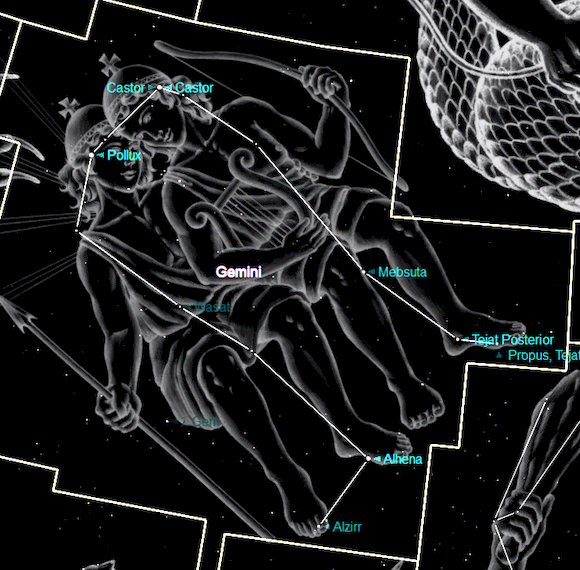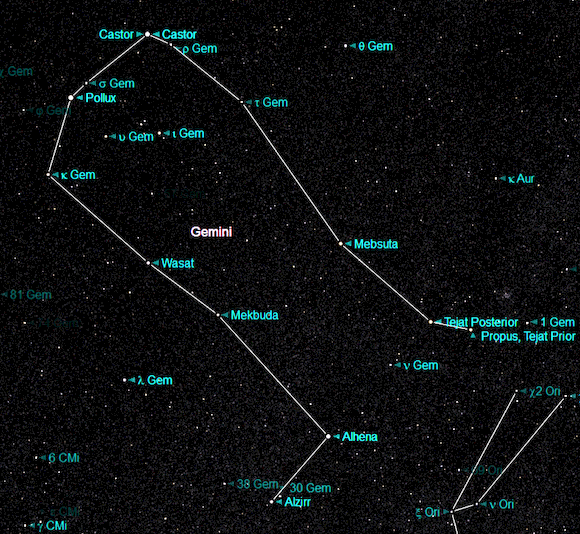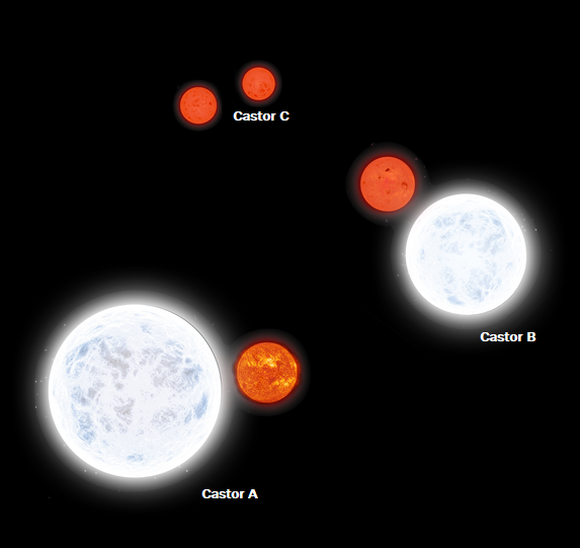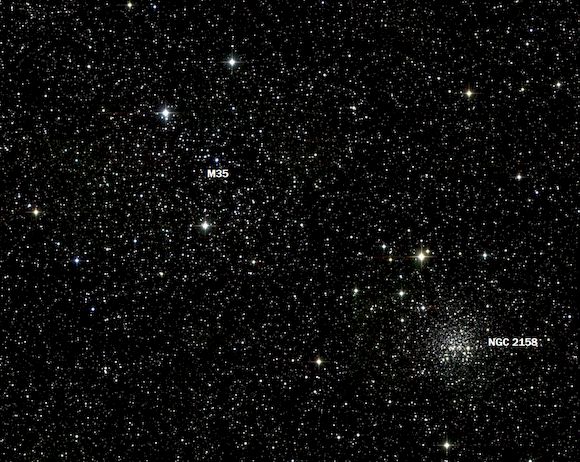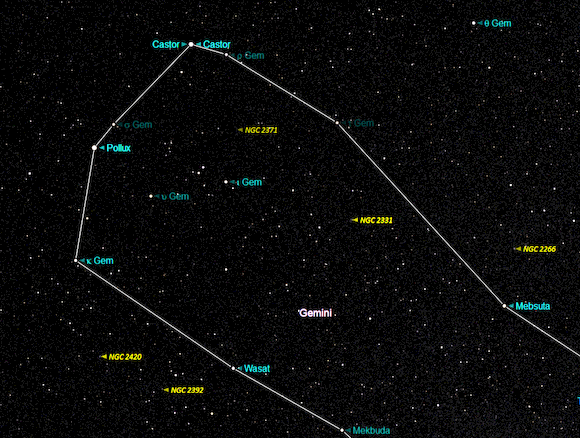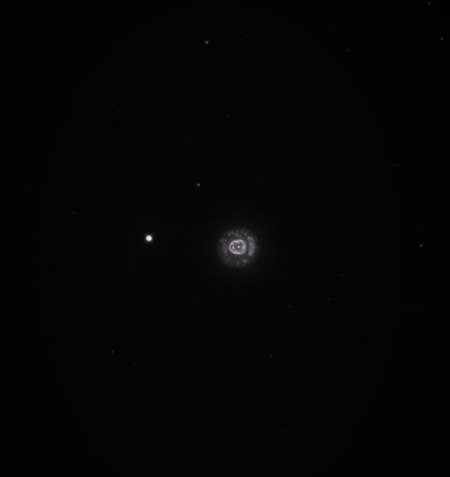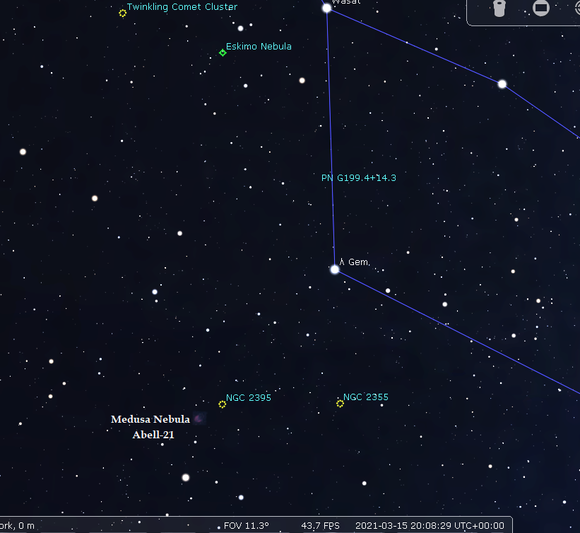Located to the upper left of Orion, Gemini is one of the original 48 constellations in the northern hemisphere documented by the 2nd century AD astronomer Ptolemy. Gemini has long been associated with the concept of twins, in particular from Greek legend, Castor and Pollux. According to this they were the sons of Leda and Zeus and in the Greek world were often venerated by mariners, invoked for protection against the perils of the sea. As such, in the quest to find the golden fleece, the twins sought to guide and protect the Argonauts in their adventures.
The electrical glow seen in ships rigging during stormy weather often called St Elmo's Fire was associated with the guiding spirit of the Twins and called the Ledaean lights. In some versions of the twins legend only Pollux was immortal, being the offspring of Zeus and Leda, whereas, mortal Castor was the son of Leda and King Tyndareos of Sparta and brother of Clytemnestra and Helen of Troy. Periodically Pollux would share his immortality with Castor. In India they were the Acvini, the 'Horsemen', though only in western culture is Castor identified as being such, whereas Pollux excelled at boxing. In Roman culture they were believed to guide Roman armies to victory.
In classical antiquity, Cancer was the location of the Sun on the first day of summer (June 21). During the first century AD, axial precession shifted this into Gemini. In 1990, the location of the Sun on the first day of summer moved from Gemini into Taurus, where it will remain until the 27th century AD.
The constellation contains over 80 stars of naked eye visibility, including the 17th and 23rd brightest stars in the sky. Alpha gemini or Castor is actually not the brightest star in Gemini, that honour goes to beta, or Pollux. It has been suggested one of the stars may have undergone some kind of transformation, or that Johann Bayer did not carefully distinguish which of the two was the brighter when he assigned his eponymous designations in 1603.
- α Gem (Castor) - the “Horseman” is the 23rd brightest star in the night sky appearing as a magnitude +1.6 single white star to the naked eye and is some 47 light-years from Earth. Appearances can be deceptive though, as anyone who has observed Castor through a decent telescope will testify. It has been known since the late 17th century that Castor is a very fine double star and the first true physical binary to be recognised. Castor A is a spectral A1V star, whilst Castor B is an A5 class star. The two stars revolve about their centre of gravity in roughly 4 centuries with a mean separation of 90AU or 8.4 billion miles. A much fainter 9th magnitude third star; Castor C, accompanies the main pair. Our Castor system is far from complete however, as each star is itself a spectroscopic binary, making the system a sextuplet!
The two ‘A’ type main sequence Castor A stars (mag 1.99) are separated by around 4 million miles and have an orbital period of just over 9 days. They are almost identical in size and luminosity, being twice the Suns diameter and 12 times more luminous. The two components of Castor B are even closer, perhaps only 2.7 million miles and are 1.5 times the solar diameter and 6 times more luminous. Castor C is a ‘in line of sight’ Algol-type eclipsing binary star, both stars being red dwarfs of 9th magnitude just 1.7 million miles apart!
- β Gem or Pollux – the Boxer, is an orange-hued giant star of magnitude 1.16 making it the 17th brightest star in the heavens. This K0 3 star is located round 34-35 light-years from Earth, quite close to the standard 10 parsec or 32.6 light years distance used for calculating absolute magnitude. Its apparent and absolute magnitudes are therefore very similar. When compared to Castor, the observer is immediately struck by the amber hue of Pollux, which is an Arcturian type star, around 35 times more luminous and 11 times the diameter. Pollux has an extrasolar planet revolving around it.
- γ Gem (Alhena) is a blue-white hued star of magnitude 1.9, 105 light-years from Earth. The true luminosity is over 150 times our Sun.
- δ Gem (Wasat) is a long-period binary star 56 light-years from Earth. The primary is a white star of magnitude 3.5, and the secondary is an orange dwarf star of magnitude 8.2. The pair are separated by around 100AU. The period is over 1200 years. It was near Wasat that Pluto was discovered in 1930.
- ε Gem (Mebsuta), is a mag 3 double star and includes a G type primary yellow supergiant almost 6000 the Suns luminosity. The companion is 9th mag and may not be related to the primary. It can be seen in a telescope of modest size. They reside around 1000 light yrs away.
- ζ Gem (Mekbuda) is a double star, whose primary is a Cepheid variable star with a period of 10.2 days; its minimum magnitude is 4.2 and its maximum magnitude is 3.6. It is a yellow supergiant, 1,200 light-years from Earth, with a radius that is 60 times solar, making it approximately 220,000 times the size of the Sun. The companion, a magnitude 7.6 star, is visible in binoculars and small amateur telescopes.
- η Gem (Propus) is a binary star with a variable component. 380 light-years away, it has a period of 500 years. The primary is a semi-regular red giant with a period of 233 days; its minimum magnitude is 3.9 and its maximum magnitude is 3.1. The secondary is of magnitude 6. They can only be split in 12" or larger scopes. The planet Uranus was discovered close to Propus by William Herschel in March 1781.
- κ Gem is a binary star 143 light-years from Earth. The primary is a yellow giant of magnitude 3.6; the secondary is of magnitude 8. Due to the discrepancy in brightness, they can only be split in larger amateur instruments.
- ν Gem is a double star separated in binoculars and small amateur telescopes. The primary is a blue giant of magnitude 4.1, 550 light-years from Earth, and the secondary is magnitude 8.
- Mu Gem (Tejat) is the Bayer designation for a star in the northern constellation of Gemini. It has the traditional name Tejat Posterior, which means back foot, because it is the foot of Castor, one of the Gemini twins.
Deep Sky Objects
There are numerous deep sky objects within Gemini, the feet of which 'paddle' in the stream of the Milky Way. Curiously there is only one messier object within Gemini-M35.
M35 (NGC 2168) is a very fine and large, elongated open cluster of magnitude 5, discovered in the year 1745 by Swiss astronomer Philippe Loys de Chéseaux. It has an area of approximately 0.2 square degrees, the same size as the full moon. It is visible to the unaided eye under very dark skies; but for most binoculars are required. In a telescope it is a fine sight. The 200 stars of M35 are arranged in chains that curve throughout the cluster; it is 2800 light-years from Earth. Another open cluster in Gemini is NGC 2158. Visible in large amateur telescopes and very rich, it is more than 12,000 light-years from Earth.
NGC 2392 is a compact planetary nebula with an overall magnitude of 9.2, located 4,000 light-years from Earth. In a medium + amateur telescopes, its 10th magnitude central star is just about visible, along with its blue-green elliptical disk. It is said to resemble the head of a person wearing a parka. It is also known as the 'Eskimo', 'Clown's face' or 'Lion face' nebula.
NGC 2392, the Eskimo, Clown face or Lion face Nebula.
10" scope or larger required for 'mane' (click for larger image)
The Medusa Nebula, also known as Abell 21 and Sharpless 2-274, was until the early 1970s thought to be a supernova remnant. After studies on the nebula's expansion velocities, it was later re-classified as an old planetary nebula.
Other objects include NGC 2129, NGC 2158, NGC 2266, NGC 2331, NGC 2355, and NGC 2355
Finally, the Geminids is one of the most prolific meteor showers with a radiant near to Castor. The shower peaks on December 13–14 with a maximum rate of approximately 100 meteors per hour. You won't spot on geminids in March of course, but if you get chance this month, do check out the heavenly brothers, there's plenty to view.
Chart credits :- Stellarium and Starry Night Pro plus 8
- Log in to post comments

